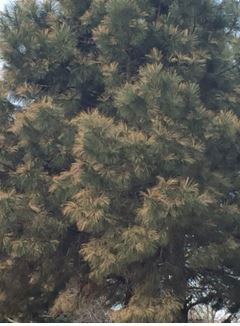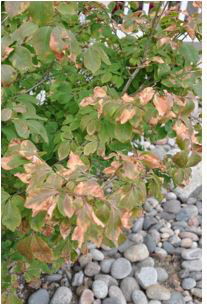
Typical Colorado Front Range winters include periods of warm, windy, low-humidity days with no snow cover and extended dry periods.
What trees are prone to winter burn?
Needled and broadleaved evergreens, especially last year’s transplants, are very prone to winter desiccation (“winter burn”) under these conditions. As the plants hold their leaves, they continue to transpire which becomes difficult during warm, dry winter periods. Below ground small “hair roots” may die in dry soils leaving roots unable to replace lost leaf moisture.
What do trees look like when they have winter burn?

The resulting water deficit causes leaf scorch of broadleaf evergreens like Manhattan euonymus, pyracantha, Oregon grape, holly and English ivy. Needled evergreens, especially Dwarf Alberta spruce, certain junipers, and arborvitae, may develop extensive needle browning. Pines show needles with a “half green, half brown” look. Desiccation symptoms may be worse on evergreens in difficult sites such as windswept areas, roadsides or medians, southwest sides of buildings, and those with limited rooting areas. Symptoms often appear on the most recent growth that is more succulent and prone to drying.
How can I prevent winter burn?
Homeowners should water in fall to send evergreens into winter with good soil moisture. As dry periods in winter become extended (generally over a month), water again. For more detail see CSU Extension fact sheet 7.211 Fall and Winter Watering. Applied in Oct/Nov, anti-transpirant sprays may help to reduce winter desiccation of evergreens.
Note that similar desiccation symptoms can result from root damage caused by certain deicing salts used on nearby sidewalks and roadways.



